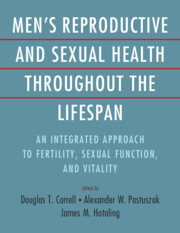 Men's Reproductive and Sexual Health Throughout the Lifespan
Men's Reproductive and Sexual Health Throughout the Lifespan from Section 3 - Clinical Evaluation and Treatment of Male Infertility
Published online by Cambridge University Press: 06 December 2023
Men with spinal cord injury often suffer from erectile dysfunction, ejaculatory dysfunction, infertility, and hypogonadism. Restoration of sexual and reproductive functions is a top priority and efficient treatment modalities exist. Erectile dysfunction can be treated with phosphodiesterase-5 inhibitors and if unsuccessful intracavernosal injections can be tried. When injections fail a penile implant can ultimately be an option. Anejaculation and the resulting infertility are treated in a stepwise approach with penile vibratory stimulation, electroejaculation and surgical sperm retrieval followed by assisted reproduction. Assisted ejaculation is an effective and safe procedure but carries a risk of autonomic dysreflexia, especially in men with injuries at the level of T6 or above. Autonomic dysreflexia is an unregulated and uncontrolled response of the sympathetic nervous system but it can be safely managed. Hypogonadism is more prevalent in men with spinal cord injury compared to the general population and testosterone replacement therapy can be beneficial for alleviating symptoms of low testosterone, but testosterone-related spermatogenic suppression needs to be considered in men who wish to initiate a pregnancy.
To save this book to your Kindle, first ensure [email protected] is added to your Approved Personal Document E-mail List under your Personal Document Settings on the Manage Your Content and Devices page of your Amazon account. Then enter the ‘name’ part of your Kindle email address below. Find out more about saving to your Kindle.
Note you can select to save to either the @free.kindle.com or @kindle.com variations. ‘@free.kindle.com’ emails are free but can only be saved to your device when it is connected to wi-fi. ‘@kindle.com’ emails can be delivered even when you are not connected to wi-fi, but note that service fees apply.
Find out more about the Kindle Personal Document Service.
To save content items to your account, please confirm that you agree to abide by our usage policies. If this is the first time you use this feature, you will be asked to authorise Cambridge Core to connect with your account. Find out more about saving content to Dropbox.
To save content items to your account, please confirm that you agree to abide by our usage policies. If this is the first time you use this feature, you will be asked to authorise Cambridge Core to connect with your account. Find out more about saving content to Google Drive.